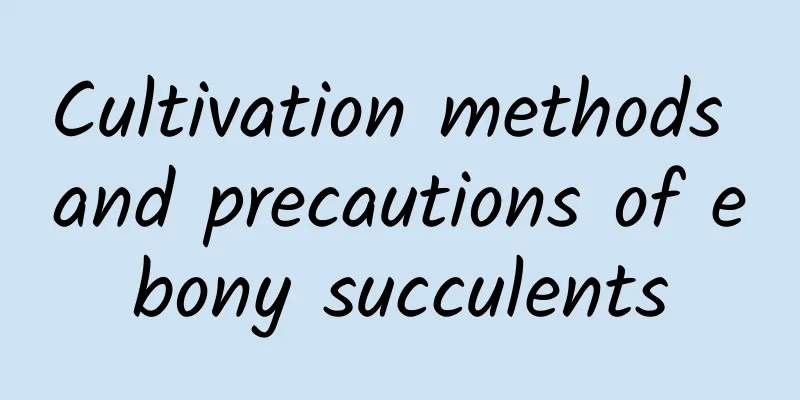Cultivation methods and precautions of ebony succulents

|
Ebony succulent is a relatively easy-to-grow succulent plant. Some people always say that it is easy to kill ebony succulent, mostly because they do not master the correct cultivation methods. Generally speaking, as long as the growth conditions in all aspects are suitable, it can be maintained in a relatively good state all year round, will not fade suddenly, and can withstand slightly higher temperatures. How to grow ebony succulents1. Soil Cultivating ebony succulents requires soil with good air permeability and water permeability, because its leaves themselves contain a lot of water. If water accumulates in the soil, root rot is likely to occur. Generally, peat soil, river sand and perlite can be mixed in a certain proportion and used. 2. Watering Ebony prefers a drier growing environment, so don't water it too frequently. During the peak growth period in spring and autumn, you can water it thoroughly after most of the soil is dry. In summer and winter, you must follow the principle of watering thoroughly when the soil is dry. 3. Temperature When its growth temperature exceeds 35 degrees, we need to provide it with appropriate shade and keep it in a well-ventilated environment. When the temperature drops below 5 degrees in winter, we need to move the ebony to an environment with a temperature above 10 degrees to avoid frostbite. 4. Fertilization Ebony is not a succulent that likes fertilizer. Generally, fertilization should be stopped during the slow growth period, otherwise it will easily cause the roots of ebony to burn. During the vigorous growth period in spring and autumn, it is enough to apply nitrogen, phosphorus and potassium triple fertilizer once every 20 to 30 days. Precautions for the maintenance of ebony succulents1. Shelter from the rain During the rainy summer months, ebony succulents are more afraid of being caught in the rain. After being caught in the rain, it is easy for their leaves to turn black and rot, and their roots and leaves to rot, so you must take measures to avoid the rain. 2. Ventilation The growth of ebony succulents should not be in a poorly ventilated environment, especially in a hot and humid environment. If the ventilation is not good, the ebony will definitely turn black and rot due to the humidity and heat. |
<<: Can passion fruit be propagated by cuttings?
>>: The pros and cons of the Chenonceau Rose
Recommend
How to prune and propagate Aquilegia
1. How to trim 1. Pruning time: The pruning time ...
The efficacy and function of Pueraria root
1. Protect liver Pueraria root can effectively im...
Ganoderma lucidum cultivation conditions and breeding environment
Introduction to Lingzhi Ganoderma lucidum is also...
What to do if you water the crabapple too much?
Overwatering Begonias Judging if there is too muc...
Maintenance methods and precautions for bonsai of Pinus truncatula
During the care of the Pinus tabulaeformis bonsai...
If you come across these two kinds of "waste", take some home. The plants will benefit from eating them as coarse leaf fertilizer!
Winter has quietly entered the cold winter stage....
Cutting method of wine bottle orchid
Cutting temperature The most suitable temperature...
Is Green Apple Arrowroot Toxic?
1. Is it toxic? Generally speaking, plants in the...
When does orchid bloom? How to grow orchids so they bloom
1. Orchid flowering time The flowering time of or...
What is the best month to plant kale?
Kale is a biennial herb and a horticultural varie...
Can Monstera bloom?
Can Monstera bloom? Monstera can bloom, but it is...
What plants to place at home to attract wealth and prosperity
1. Lucky Bamboo Lucky bamboo is a common green pl...
How to plant purple pearl seeds
1. Operation method 1. Seed collection. If the fl...
What is the function of the roots of spider plants
1. Root characteristics The many functions of spi...
The molting process of Lithops and how to cut off water
1. Molting process Theoretically, the molting pro...









